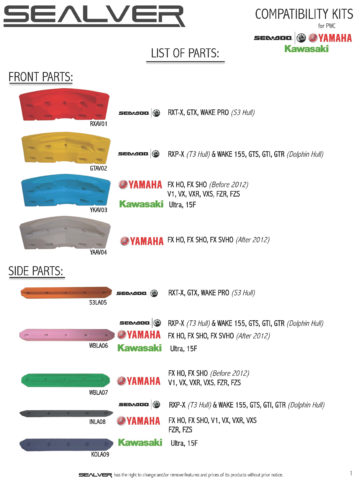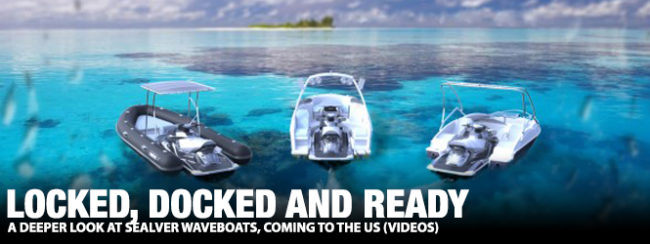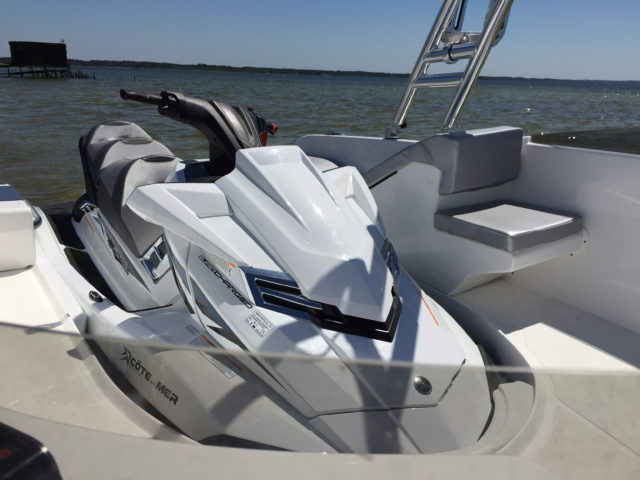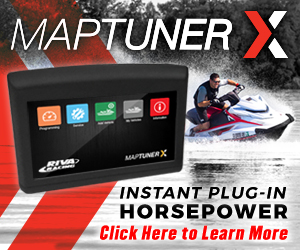We recently “re-introduced” you to the Sealver Waveboat after its initial release three years ago. As a PWC-powered boat manufacturer Sealver has made a lot of new additions to its lineup. In case you haven’t gotten our drift with the recent focus on these nifty little vessels, we have been highly anticipating their distribution here in the US. In fact, we have just received word that these Waveboats are expected to arrive sometime next year.
 You heard that right! 2018 is expected to be the year that Americans will finally get their hands on these boats. The French-based company has only been able to make them available in European and other overseas countries since their introduction and although we do not have exact dates on the distribution yet, we do have quite a bit of other pertinent technical information which would interest potential buyers.
You heard that right! 2018 is expected to be the year that Americans will finally get their hands on these boats. The French-based company has only been able to make them available in European and other overseas countries since their introduction and although we do not have exact dates on the distribution yet, we do have quite a bit of other pertinent technical information which would interest potential buyers.
Up until now, there was a lot of uncertainty and lack of details that kept us in the dark on things such as the PWC-to-boat interface and securing system which we have been able to shed some light on. Additionally, we have received further details regarding what PWC makes and models are compatible with the boats and how the interchange works to switch models should the owner have multiple types of PWC.
Even further details that we have been able to pull out of the bag include the performance of these units particularly in large bodies of water where water conditions can get quite rough and choppy as well as more technical details and specifications. But enough about what we haven’t been able to tell you until now, because frankly we are in the present so let’s cut to the chase and tell you what we know.
Perhaps the biggest detail was how the heck do these things actually work to keep the ski and boat locked together and functioning as one running unit. The answer lies within Sealver’s unique interlock system called the compatibility kits. The compatibility systems consists of a front unit attached to the front portion of the Wave boat’s guide and precisely contours and accepts the front of the PWC’s hull.
There is also a side rail that bolts to both sides of the boat’s guide. This cradles the side of the PWC on either side of the hull/deck bond lines. Some of the side rails utilize a two-piece system that goes above and below the bond line and other side rails have a one-piece setup with a groove that the side of the PWC locks into depending on the make and model of PWC that you will be using.
Additionally, there is locking for the rear via a retractable strap boat buckle system. The retractable straps are a one-size-fits-all system. The strap and support system is bolted on to the rear portion of the Sealver boat. To attach to your PWC, once it is driven or moved into the boat, simply pull on the retractable strap and buckle it to the existing rear tie down eyelets on your PWC as seen in the last segment of this video here.
So just how reliable is this system in keeping your ski and Waveboat firmly and precisely locked in place and functioning as one unit especially in rough water conditions? We had the same exact question for the nice folks at Sealver and they gave us some reassuring feedback. The bottom line is that the PWC will never come apart from the boat in any water condition thanks to the unique compatibility kits and the boat buckle system. Once locked in place, you can maneuver forward, backward, and in any direction through any water condition and the entire system will act as one fixed boat unit.
The boat buckle system is made out of high quality stainless material for reliability and corrosion protection. The front unit and side rails of the compatibility system are made from a high density mold which gives precise alignment and rigidity. What this basically means is that you can pretty much do anything you want to these boats and your ski won’t come loose.
Of course, the Sealver Boat Lineup consists of a wide variety of models and sizes to choose from and they range in their abilities to handle different water conditions much like a conventional boat or PWC has different handling characteristics based on the model and size. According to the manufacturer, the 444 series is smaller however it has an incisive carene hull design to break through waves. The 525 series boat does navigate easier in calm seas such as small lakes and rivers. Nonetheless, the rigid attachment system will stay put in any condition as mentioned before. We suppose this would be equated to someone taking a rec-lite PWC in the ocean to do some wave jumping. Your legs and back might be a little sore the next day, but your ski will still work fine.
Sealver also manufactures the larger 656 lineup which is the largest at the moment and especially adapted for any type of water condition. They even make a Sealver Pro brand designed to be used by Police, Military, and Rescue departments. You know these models are going to take some serious pounding and we can imagine that they are equally equipped to handle it.
Another area that we promised to remove the magician’s cover on was the customer who may purchase one Sealver Waveboat but he or she has more than one PWC to be used or plans to purchase a different PWC model down the road (or in this case down the water). For those keen readers, you will have already noticed that the secret lies within the compatibility kits mentioned above. The front unit and side units are bolted to the Waveboat. These bolts are easily removable allowing you to simply bolt up a new compatibility kit to change PWC models on the same Waveboat platform. Since the retractable boat buckle system is not model-specific, it is a one-size-fits-all system.
According to Sealver, they can provide compatibility kits for virtually any model PWC whether it be a Sea-Doo GTI, S3, T3 hull, a Yamaha VX, FZ, FX series, or a Kawasaki STX-15F or Ultra series. Although the smaller runabouts like the Sea-Doo Spark, will not fit in the full size Sealver boats, we have found that they make a small inflatable unit which wraps neatly around the Spark hull as shown in the photos.
These folks across the big pond certainly seem like they are constantly evolving and innovating new ways and ideas to support their unique Wave boats. We also asked them how it would work to get navigation lights, sound systems, and other electrical accessories integrated within the boats. Suppose you want to take the ski out for a quick spin while your friends or family hangs behind in the Wave boat and they want to be able still crank up the tunes. Sealver has proposed a standalone battery pack with recharge capability in order to keep that electron juice flowing to all the necessary accessories.
At this time, we do not have any US-based pricing information and since the European-based prices do not include taxes, export, and distribution costs, it doesn’t mean a whole lot to us now. We will be sure to share these details with everyone along with more accurate distribution schedules once we receive more information. Until then, we can only wait in high hopes that we can get one of these units to test out.













So where can I buy a Sealver in the US??
So far, they’re not yet USCG approved.
Any updates on USCG approval? Can I buy one in Canada and trailer it over to US?
Both good questions. We’ve heard that Sealver will be coming to the US in 2020. In fact, they’re expected to be at a handful of boatshows on the East Coast early in the year.
Anyone have an update on US availability? I see there is one place online where it looks like you can buy one in California but I am in the MidWest. I have an info request to the Canada HQ because if possible I would pick one up and import it depending on cost.
We link to the Miami, FL dealer.
Hi! I am in California, do you perhaps have the link to the dealer?
20 seconds on Google takes you to the site, with the contact info at the bottom:
https://www.thewaveboat.com/
Mountdorawaveboat.com is their email. They are in Mount Dora florida. Just opening. They have the 444, 656 and 525 in stock. As of 10/15/2020 they are the only ones that have all 3 in stock.